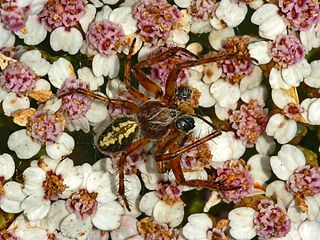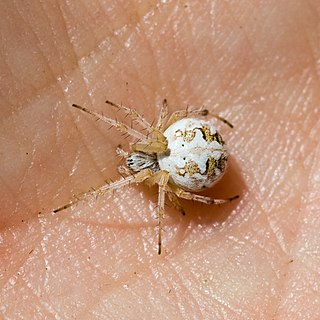
Huntsman spiders, members of the family Sparassidae, catch their prey by hunting rather than in webs. They are also called giant crab spiders because of their size and appearance. Larger species sometimes are referred to as wood spiders, because of their preference for woody places. In southern Africa the genus Palystes are known as rain spiders or lizard-eating spiders. Commonly, they are confused with baboon spiders from the Mygalomorphae infraorder, which are not closely related.

The Araneomorphae are an infraorder of spiders. They are distinguishable by chelicerae (fangs) that point diagonally forward and cross in a pinching action, in contrast to the Mygalomorphae, where they point straight down. Araneomorphs comprise the vast majority of living spiders.

Fortín de las Flores is a city in the Mexican state of Veracruz. Fortín de las Flores is the municipal seat of Fortín municipality, which borders the municipalities of Córdoba, Naranjal and Ixtaczoquitlán. It stands on Federal Highways 190 and 180 and the Mexico City to Veracruz railway.

Psechridae is a family of araneomorph spiders with about 70 species in two genera. These are among the biggest cribellate spiders with body lengths up to 2 centimetres (0.79 in) and funnel webs more than 1 metre in diameter.

Aculepeira ceropegia, the oak spider, is an orb-weaving spider species belonging to the family Araneidae.

Gasteracantha cancriformis is a species of orb-weaver spider. It is widely distributed in the New World.

Metepeira labyrinthea, the labyrinth orbweaver, is a spider, with thin legs and a round, bulbous abdomen It is a member of the genus Metepeira in the family Araneidae. The female’s length is 5.3 mm, its carapace 2.3 mm, abdomen 3.3 mm, and extended legs 18.4 mm. The carapace is brown or gray, and the abdomen is dark with a white pattern. The legs alternate pale brown and dark brown, and the sternum is dark brown with a longitudinal yellow mark. The male spider is three-quarters of the female’s length, or slightly larger, with a darker carapace and with greater contrast between dark and light areas of the legs. Metepeira are easily distinguished from other Araneidae by their light eye region, white median line on the sternum, relative length of the leg segments, small male palpus, weakly sclerotized epigyne and the special composite web.

Metepeira is a genus of orb-weaver spiders first described by F. O. Pickard-Cambridge in 1903. The name is derived from the Ancient Greek μετά and the obsolete genus name Epeira, denoting a genus similar to Epeira.

Alireza Zamani is an Iranian arachnologist and taxonomist.
Metepeira ventura is a species of orb weaver in the spider family Araneidae. It is found in the United States and Mexico.
Metepeira spinipes is a species of orb weaver in the spider family Araneidae. It is found in the United States and Mexico.

Metepeira arizonica is a species of orb weaver in the spider family Araneidae. It is found in the United States and Mexico.
Metepeira crassipes is a species of orb weaver in the spider family Araneidae. It is found in the United States and Mexico.
Metepeira gosoga is a species of orb weaver in the spider family Araneidae. It is found in the United States and Mexico.
Metepeira grandiosa is a species of orb weaver in the spider family Araneidae. It is found in North America.
Metepeira palustris is a species of orb weaver in the spider family Araneidae. It is found in the United States and Canada.
Metepeira comanche is a species of orb weaver in the spider family Araneidae. It is found in the United States and Mexico.
Metepeira minima is a species of orb weaver in the spider family Araneidae. It is found in a range from the United States to Honduras.
Metepeira datona is a species of orb weaver in the spider family Araneidae. It is found in the United States and Greater Antilles.

Neospintharus furcatus is a species of cobweb spider in the family Theridiidae. It is found in a range from the United States to El Salvador and the Caribbean Sea. It is primarily kleptoparasitic.










